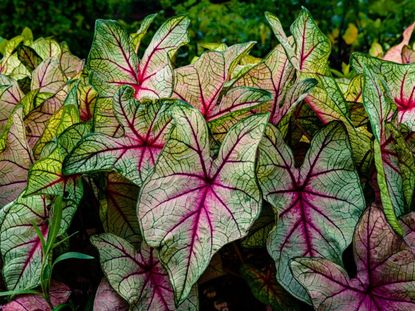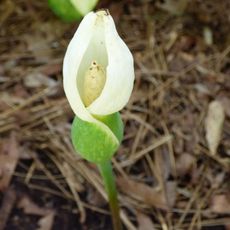Caladium Plant Problems – Caladium Plant Pests And Disease


Caladiums are foliage plants, grown for their showy leaves. The leaves have incredible color combinations including white, green pink and red. They are shaped like arrowheads and can get up to 18 inches long. Caladium plants are native to Central and South America. They are very popular houseplants but they are not without their share of caladium plant problems. Read on to learn about caladium plant pests and other problems with caladium.
Problems with Caladium
Like other plants, caladiums can have problems. Caladium plant problems range from those caused by improper cultural practices to diseases and pests.
Cultural Practices
In order to start preventing caladium problems caused by improper cultural practices, learn how to take care of your plant. Caladiums grow from tubers that look like bulbs, and if the tubers are injured in storage, the plants can be stunted. Carefully stock tubers in a garage or porch at temperatures between 60 and 90 degrees Fahrenheit (15 to 32 C.). Colder or hotter temperatures will create stunted growth in the plants. Caladiums like sunlight, but not suddenly. If your cultivars were grown during cloudy weather and suddenly are faced with bright light, they may get sunburned. You’ll see brown blotches on the leaves. If this happens, just increase the plant’s shade. Too much water or fertilizer near the plant tubers can also create caladium plant problems. Take care with irrigation and fertilization and you’ll be preventing caladium problems.
Caladium Plant Pests
Caladium plants are not typically troubled by insects, but sometimes caladium plant pests nibble their leaves or cell sap. Caterpillars and aphids can be problems. Your best defense against caladium plant pests is vigilance. If you see ragged margins on foliage, look for the creatures and hand pick them off the plants. If the infestation is out of control, use Bacillus thuringiensis, known as "Bt," that’s made for caterpillar control. Aphids can be bothersome, although they generally do not pose real threats to the plants. Wash them off with the hose or, if necessary, use horticultural soap or neem oil to control them.
Diseases of Caladium Plants
Caladium grow from tubers and the diseases of caladium plants are those that attack the tubers. Usually these diseases are caused by fungal pathogens, such as Rhizoctonia and Pythium species. Sometimes, these are present in the dormant tubers. If you want to start preventing caladium problems from fungus, immerse the tubers in hot water – water heated to 122 degrees Fahrenheit (50 C.) prior to planting or storing. Leave them in for 30 minutes to kill harmful fungi. Make sure the tubers thoroughly dry.
Gardening tips, videos, info and more delivered right to your inbox!
Sign up for the Gardening Know How newsletter today and receive a free download of our most popular eBook "How to Grow Delicious Tomatoes."

Teo Spengler has been gardening for 30 years. She is a docent at the San Francisco Botanical Garden. Her passion is trees, 250 of which she has planted on her land in France.
-
 Urban Composting Guide: How To Compost In The Middle Of The City
Urban Composting Guide: How To Compost In The Middle Of The CityUrban composting does not have to be daunting. You can compost in the city, and maybe even try some urban worm composting!
By Mary Ellen Ellis
-
 Shrub Diseases And Pests To Watch Out For
Shrub Diseases And Pests To Watch Out ForShrub diseases and pests can be challenging. Learn how to recognize and eradicate them before they can present a danger to your plants.
By Susan Albert
-
 What Is A Strap Leaf Caladium: Growing Strap Leaf Caladium Bulbs
What Is A Strap Leaf Caladium: Growing Strap Leaf Caladium BulbsCaladium foliage is celebrated by the warm-climate gardener as well as houseplant enthusiasts from all climates. Click here for more info.
By Mary Ellen Ellis
-
 Winter Care For Caladiums – Learn About Caladium Care In Winter
Winter Care For Caladiums – Learn About Caladium Care In WinterCaladium is native to South America. Because of this, it is used to hot temperatures and needs special treatment during winter in cooler climates. Learn more about storing caladium bulbs and how to care for caladium bulbs overwinter here.
By Liz Baessler
-
 How To Grow Caladiums Indoors: The Ultimate Care Guide
How To Grow Caladiums Indoors: The Ultimate Care GuideGrowing a caladium indoors is a special treat for devoted houseplant parents. With its colorful shapely leaves and need for only indirect light, a caladium plant is a lovely indoor addition.
By Tonya Barnett
-
 Do Caladiums Bloom: What Is The Flower-Like Bud On Caladium Plant
Do Caladiums Bloom: What Is The Flower-Like Bud On Caladium PlantBlooming on caladium plants isn't common, but tubers planted in favorable locations tend to produce small flowers. There are several schools of thought on what to do with caladium flowers. This article will explain more. Click here.
By Bonnie L. Grant
-
 Tips For Growing Fancy Leaf Caladiums
Tips For Growing Fancy Leaf CaladiumsFancy leaf caladiums are a great addition to the often all-too-green shade garden. Before you grow fancy leaf caladiums, there are a few things you should know about them and their care. This article will help.
By Jackie Rhoades
-
 Grow Caladiums: Best Care For Elephant Ear Plants
Grow Caladiums: Best Care For Elephant Ear PlantsMulti-patterned caladiums are a firm favorite both in the garden and in indoor containers. Find out how to grow your own ‘elephant ears’ and get the most from these tropical beauties
By Tonya Barnett
-
 Planting Caladiums - When To Plant Caladium Bulbs
Planting Caladiums - When To Plant Caladium BulbsLast fall, you may have spent some time saving caladium bulbs from your garden and are now left with the question of when to plant caladium bulbs. The tips in this article can help with that.
By Heather Rhoades